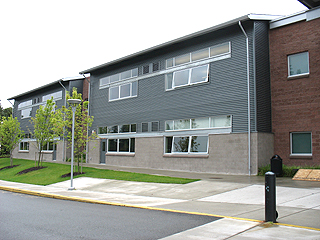|
Subscribe / Renew |
|
|
Contact Us |
|
| ► Subscribe to our Free Weekly Newsletter | |
| home | Welcome, sign in or click here to subscribe. | login |
Construction
| |
 |
September 20, 2007
Case for operable windows isn’t open and shut
Yantis Acoustical Design

Yantis
|
In recent years, architects have increasingly incorporated natural ventilation in building design.
This commitment to sustainable design is to be applauded, not only for its energy conservation, but also for human comfort. Most of us will gladly trade a few degrees of indoor temperature for increased natural ventilation and a connection to the outdoors.
A by-product of this trend, at times, is increased noise levels inside the building. Often, the increased noise is of little consequence. Offices, factories, medical facilities and retail are examples of building uses that can often withstand higher noise levels. Building uses that require lower noise levels are only good candidates for natural ventilation if located in a sufficiently quiet environment.

Signal-to-noise ratio is a term that describes the ability to hear a desired sound (signal) in the midst of noise. Building uses that require a high signal-to-noise ratio include classrooms, theaters, conference rooms, chapels and sound studios.
To the extent that a natural, unamplified voice is used in these room types, the only way to achieve a high signal-to-noise ratio is to create a low noise environment within the room.
Classroom acoustics
Recent trends in classrooms acoustics have emphasized the need for low noise levels.
Research indicates that classrooms with higher noise levels lead to poor speech intelligibility, particularly for younger students with smaller vocabularies, students with any degree of hearing impairment and children with English as a second language.
The insidious aspect of high noise levels in the classroom is that teachers are often unaware that their students cannot adequately understand their speech. Students are often hesitant to inform the teacher and don’t understand that all the students in the classroom may not be experiencing the same conditions, since listening conditions in the classroom vary with the distance from the teacher.
Noise-level standards
A significant effort among acousticians, educators, architects and engineers resulted in the creation of the American National Standards Institute standard S12.60-2002.
The standard requires a maximum noise level of 35 decibels within a classroom to achieve the required signal-to-noise ratio for natural voice. (When I say decibels, in general I am referring to A-weighted decibels, which represent loudness to the human ear.) Thirty-five decibels is roughly half as loud as the typical noise level produced by a heating and ventilating system in an office building.
The recently adopted Washington Sustainable Schools Protocol gives credit for achieving some specific classroom acoustic goals. These goals are consistent with the ANSI 12.60 standard.
Among other goals, the Sustainable Schools Protocol awards one point if classroom noise levels do not exceed an average of 35 decibels. The Washington Administrative Code is more lenient. It presently allows 45 decibels, although the informal draft of the revised code decreases this limit to 40 decibels.
Measuring noise
To achieve these classroom goals with natural ventilation, the noise levels outside the classroom must meet certain limits.
Our company measured noise levels at a recently completed school in Issaquah to determine how much “noise reduction” was provided by the school’s windows when they were open and shut. Noise reduction is the difference in sound levels inside and outside the school, so a higher noise reduction means that the interior sound levels are quieter.
The classroom was a typical classroom size, roughly 27 by 29 feet, with an average ceiling height of 10 feet. About half the classroom wall facing the exterior was glass. The school is exposed to a busy two-lane road approximately 125 feet from the edge of the classroom exterior wall, although much of the direct sound of the road was at least partially shielded by the slightly elevated parking lot.
Two sections of windows, each 4 feet tall by 5 feet wide, were operable. The windows pivoted from the top, the bottom portion extending roughly 6 inches toward the parking lot, to allow the natural ventilation.
Noise levels were measured simultaneously inside and outside the classroom. Measurements inside the classroom were taken at seats near the windows, in the middle of the room and at the seats furthest from the windows.
Surprisingly, the noise reduction did not vary significantly with seating location. The noise reduction provided by windows that were shut was 32 decibels and the noise reduction provided when both of the exterior windows were completely open was 18 decibels.
Adding the 18-decibel noise reduction to the maximum background noise levels of 35 decibels recommended by the ANSI standard and the Sustainable Schools guidelines, the maximum noise level outside the classroom would be 53 decibels when the windows are open. Another way of stating this is that the noise level outside the building cannot exceed 53 decibels if the 35-decibel interior noise level goal is to be met.
This exterior noise level is very quiet and would be uncommon at locations near busy streets, any sort of highway, or airport. Allowable exterior noise levels would be 5 decibels higher if the Washington Administrative Code draft classroom noise levels were used as the design goal.
Planning for balance
The classroom window measurements indicate that natural ventilation should be considered only for quiet school sites in general.
Some noisier sites might become viable candidates for natural ventilation by strategic, early planning with regard to the site design. It may also be possible to design operable exterior windows that reduce noise more than those documented in this article. However, careful coordination amongst the design team members would be required because of the delicate balance between sufficient window opening to allow the needed natural ventilation and additional restriction on window openings to improve the noise reduction.
If natural ventilation is a design goal for a school project, the design team should evaluate the exterior noise levels, site design and window configuration very carefully to achieve the proper balance between energy conservation and a desirable classroom teaching environment.
Michael R. Yantis is a principal of Yantis Acoustical Design in Seattle.
Other Stories:
- Cascadia college building will be green inside and out
- Owners, designers can harness the Web too
- ‘I wish I could go to a school just like this’
- Light ‘chimneys’ cool off Tacoma school
- Performing arts spaces gain sophistication
- Lynnwood a proving ground for green schools
- Spokane takes a chance on GC/CM
- Seattle gets creative to expand bidding pool
- Public school projects fall out of favor with bidders
- Tomorrow’s schools will be greener, freer


